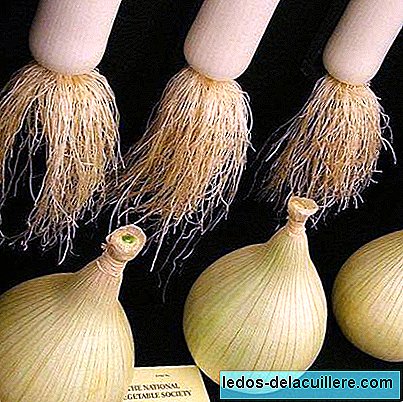
Onions, leeks and garlic belong to the amaryllidaceae family, a biennial plant native to Europe and Western Asia that is grown for its leaves, bulb and edible flowers.
We focus on the onion and the leek for feeding the baby from six months, because their nutritional properties and their ease of digestion make these vegetables suitable for children's consumption, cooked in the form of porridge.
Sometimes the introduction of the onion is usually delayed a few months in the infant feeding, but for reasons of smell and taste rather than adequacy to the baby, since it is a very aromatic vegetable. However, if we mix the onion with other vegetables to make the purees, the taste and smell are softened and there is no problem in offering it to the baby.
We will know what are the nutritional properties of these two vegetables, as well as their varieties and its way of preparation for complementary infant feeding.

The leek in infant feeding
The leek, porro, garlic porro, ajoporro or pore (Allium ampeloprasum var. Porrum) is one of the cultivated varieties of the species Allium ampeloprasum.
The leek plant is easily recognizable by its three parts: the long, lanceolate leaves (with greenish-blue tones) somewhat flat, a small white and elongated bulb from which small roots come out. For the baby's food we are interested in the central part, the white bulb.
The flavor of the leek is a little softer than that of onions, so it may be more appropriate for the first porridge.
The plant has the same medicinal properties as garlic, but in a much milder form and with the mildest active ingredients.
Water is the major component, which, together with its low carbohydrate content, converts leek into a food with little caloric intake. In addition, it has a significant amount of fiber and some vitamins and minerals: it emphasizes its potassium content (necessary for the transmission and generation of nerve impulse and for normal muscle activity).
The leek is also a rich source of magnesium (it is related to the functioning of the intestine, nerves and muscles and the formation of bones and teeth, improves immunity), calcium and iron.
Leeks are a good source of folates (they are involved in the production of red and white blood cells and in the formation of immune system antibodies) and also provide vitamins C and B6, although the latter in smaller quantities.
Vitamin C has antioxidant action, participates in the formation of collagen, bones, teeth and red blood cells, in addition to promoting the absorption of iron from food and increasing resistance to infections. Vitamin B6 acts on cellular metabolism and the functioning of the immune system.
All these properties make leek a food suitable for baby feeding, because it is rich in vitamins and minerals necessary for its correct development and a source of water and healthy energy.

Onions in infant feeding
Allium cepa, or onion, is a biennial herbaceous plant of the amaryllidaceae family. It is probably native to Central Asia, and is currently grown in all European countries of the Mediterranean, as well as in Arab countries, and the main producer is Mexico.
The onion is the bulb-shaped underground part with green and round branches, which are hollow inside. For the infant feeding the onion bulb interests, which can be of different varieties depending on the color (white or colored onion, pink, purple, red, yellow ...) and is covered with dry brown skin inedible.
Some of these varieties have a milder taste than others, and preferably we should choose these to make the baby porridge, although when cooked they taste and smell soften quite a bit.
The abundance of quercitin protects the cardiovascular system. Other components present in onions such as phosphorus, silicon, iron, iodine or potassium benefit the proper organic functioning. It has a very low content of sugars, fats and calories and has fiber, which helps regulate intestinal function.
It also contains vitamin C (although in less quantity than leek) and essential vitamins for development such as B1, B3, B6, B9, E and folic acid. All these nutritional characteristics make the onion an easily digestible and healthy food for the baby.
How to prepare onion and leek
To crush the onion or leek when making the baby porridge you have to boil them or steam them. They should not be overcooked because they would lose much of their nutrients, but they should be soft.
To prepare the leek we will have to cut the green leaves and roots, and stay exclusively with the most tender part of the white bulb, which we will wash well before introducing it in water to boil it.
The onion has to be peeled in its varieties that have dry outer layers, and cut the roots and leaves if any. As we know, when the onion cells are chopped and broken, an irritating substance is released that can cause the eyes of those who prepare them to cry, so it is convenient to cut them under a stream of water.
The cooking time depends on the type of pot we use and the hardness of the water, but we must ensure that the filaments, especially of the leek, disintegrate well when crushing them. If we prefer not to boil the leek so much, we will exclude it when it comes to beating the vegetables, although the substance that does pass to the porridge will remain in the water.
It is convenient that in the preparation of these vegetables for baby porridge combine with other vegetables that soften the taste and smell, such as peas, green beans, potatoes, sweet potatoes, zucchini, squash ... So we also add different nutrients, providing the baby's body with the benefits of more vitamins and minerals present in other vegetables.
Once cooked, the porridge with onion and leek must be consumed soon because it quickly loses its nutrients. You can add a teaspoon of raw olive oil to the puree when we are going to give it to the baby, but never salt, until after the year of age.
For the next day the mash can be stored in the refrigerator tightly covered. It is not convenient to overheat, it is better to keep cold what the baby is not going to take and warm it up just the next day. If we are going to take longer to consume it, it is convenient to freeze it already made porridge and defrost it in the refrigerator 24 hours before the baby will eat it.
At six months the mash should be fine, but after 8 or 9 months we can leave some larger pieces, crushing the porridge less, so that the baby gets used to new textures, because in a few months he will be willing to chew solids and manipulate food itself.
As we see, onion and leek are ideal vegetables for babies thanks to its nutritional properties and its easy digestion. First they will taste them in porridge with other vegetables, then in small pieces, and finally in the recipes that the whole family will savor as part of a healthy diet.












